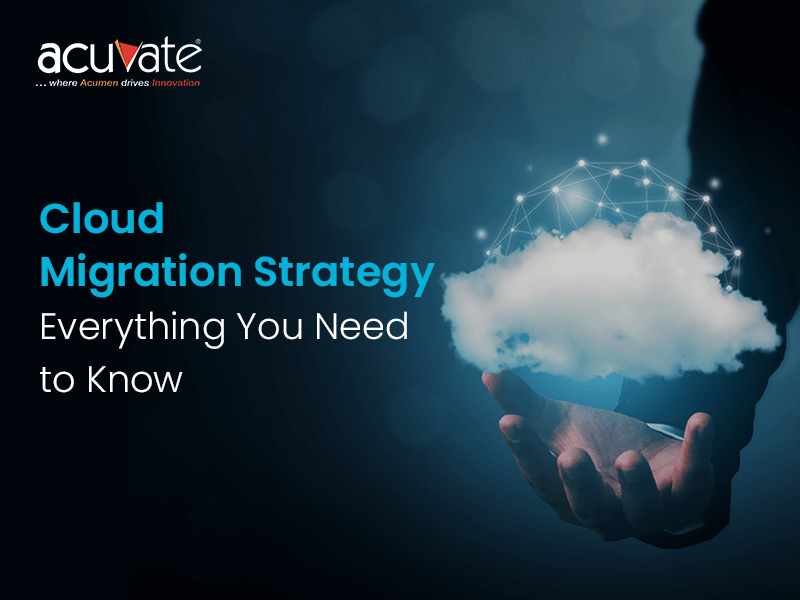Have you been planning to migrate your company’s legacy applications and datasets, infrastructure, and IT resources to an advanced cloud environment? If yes, you need to prepare a fool-proof checklist and chalk out a powerful cloud migration strategy that would be right for your business and efficiently cater to its specific requirements. Needless to say, the cloud migration approach of one company would differ from the other, with each business having its own unique cloud migration needs. The potential of cloud services is immense and can drive unparalleled value and growth for each business distinctively.
How does Cloud Migration work?
Before you take the plunge, it is crucial to understand the nitty-gritties involved in the cloud migration process and how to go about it. Take care of the below-mentioned points before you take the giant leap –
A) Look inwards
Define the broad business objectives that you want to achieve through cloud migration. Based on these objectives, have a closer look at your existing IT infrastructure. Choose the applications to migrate – those that you think would yield significant outcomes in the cloud environment. Well, you might not want to migrate all the applications due to various factors such as high risk involved, complex regulatory framework, cost-effectiveness, performance issues, etc.
B) Identifying the right cloud platform
Once you have zeroed down on the applications that are to be migrated, the next step is to decide where to move them. Essentially, there are three cloud models, which are as given below –
- Public Cloud – With public cloud computing, services are offered over the public internet and are shared commonly across enterprises. Typically, these services are available free of cost, or follow a pay-as-you-use model.
- Private Cloud – These cloud computing services are dedicated exclusively to a single organization and cannot be shared with any other enterprise. This gives the particular organization complete control and ownership over the cloud services.
- Hybrid Cloud – In a hybrid cloud environment, public and private clouds are merged together and utilized, wherein the resources and workloads can be seamlessly moved between the two.
Once you have chosen the cloud model, you could move a step further to choose your cloud provider – Microsoft Azure Cloud, Google Cloud Platform, Amazon Web Services or others.
C) Actual Migration
Well, it’s time now to finally migrate workloads to cloud. It is best to collaborate with industry specialists or cloud migration experts, who could perform the actual migration services for you effectively. However, as you do so, it is advisable to keep a close watch on the performance level of the applications at each stage, in order to gauge the benefits derived.
Cloud Migration Approach – Choose The Right One For Your Business
Once you have taken a deep dive into the working of the cloud migration process, the next important step is to pick up the right cloud migration strategy. Below listed are few well-established cloud migration approaches that you could choose from –
1. Rehost
This is one of the most popular, simplest and quickest way to transition to the cloud. Also commonly known as the ‘lift and shift’ strategy, rehosting essentially refers to transferring of data or applications from an existing on-premises system to a cloud environment. Simply put, rehosting is the replication of on-premises application in the cloud infrastructure. Data is seamlessly transferred from one place to another without making any code-level changes. For organizations embarking on their cloud migration journey for the first time as well as for enterprises who are looking for quick, large-scale migration solutions to meet their immediate business requirements, this proves to be the best approach.
2. Replat form
A slightly modified form of rehosting, re-platforming involves introducing few configurational changes to the existing applications to make them cloud-ready. In this strategy, the core architecture of the applications is completely retained, while only a few basic-level changes are made. This approach is commonly used by developers to improve the efficiency of the apps and optimize them to ensure more maximum productivity.
3. Re-factor/ Re-architect
This cloud migration strategy entails complete rewriting of applications to make them more agile and efficient for the cloud platform. In the long run, the re-factored applications yield maximum value and output, even in the most complex environments. Those businesses that are looking to rapidly scale up or augment their services extensively find this approach most suitable, as they are unable to derive massive scale and value from the existing IT environment. While this cloud migration strategy is considered to be slightly more costly and time-consuming than the others, it surely brightens up the long-term picture.
4. Repurchase
There are scenarios where a company decides to ends its existing licensing services and plans to switch to an altogether new platform, in order to generate greater value and efficiency. Such cloud migration strategy is known as ‘repurchase’ or ‘drop and shop’ strategy.
5. Retiring
This strategy refers to identification of applications that are no longer efficient or perhaps are not benefitting a company’s IT ecosystem anymore. These applications are then taken off the platform, as they are not considered worthy enough to be migrated to the cloud. Retiring of applications enables businesses to be more productive, as they are now able to focus only on the best-performing applications which benefit the business the most.
6. Retain
Often referred to as re-visit, this cloud migration strategy involves re–analysing the applications in a company’s digital portfolio to identify the ones which need to be retained in the on-premise infrastructure. Needless to say, not all applications are fit to rock on the cloud platform. These could be the ones which are working perfect in the existing environment and also must not be discarded. Alternatively, these applications might be requiring a considerable level of refactoring in order to migrate to the cloud. Also, in case of complex regulatory guidelines, some applications are considered best where they already are.
In Summary
Quite clearly, cloud migration is an intricate and vital process, one that cannot be decided and done overnight. Therefore, it is important for a business to partner with the right expert, one who could assist you in your cloud migration journey by competently understanding your workloads and business requirements to pave the right path meant for you. You must also find a partner who has disaster recovery and business continuity expertise, managed services for peace of mind, and can assure you of a zero data loss cloud migration journey.
Talk to Acuvate, the cloud experts, today. We are here to help!



